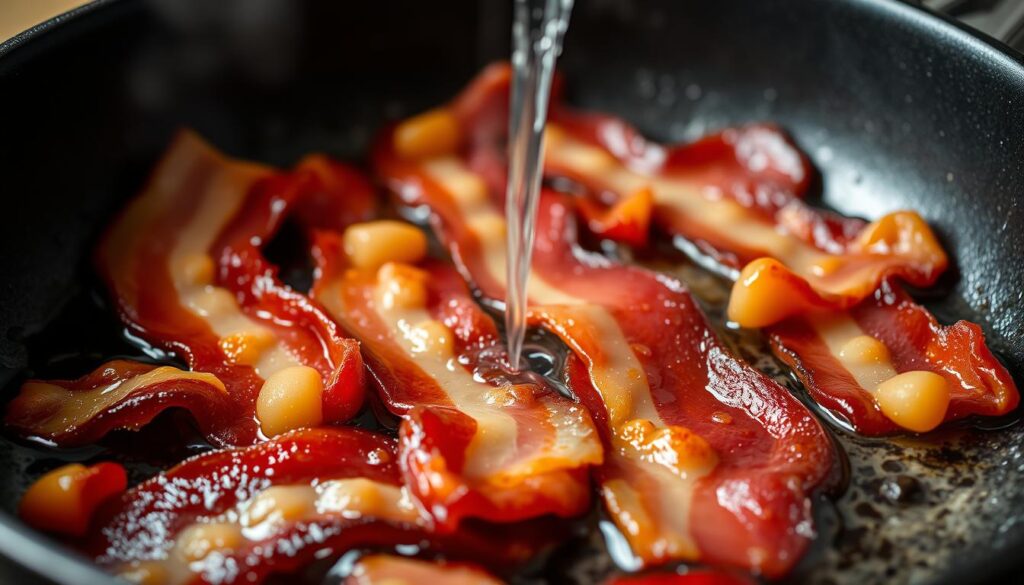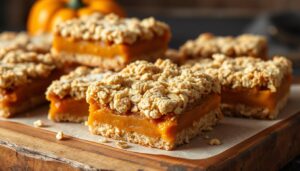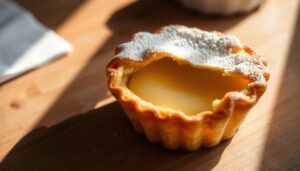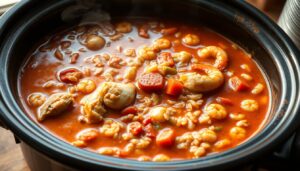Did you know over 1 million people liked a viral Instagram post about a surprising bacon cooking technique? Professional chefs use water as a secret weapon when cooking bacon. This method challenges traditional ways of cooking bacon, changing how we prepare our favorite breakfast meat. Why do chefs add water to bacon?
As a culinary enthusiast, I found out why chefs add water to bacon is not just a trick. It’s a professional cooking method that greatly improves bacon’s texture and taste. Starting bacon in a cold pan with 1-2 tablespoons of water helps render fat evenly and reduces messy grease splatters.
The technique is simple yet scientific. By gradually cooking bacon with water, chefs get perfectly crispy edges and tender meat at the same time. The water prevents burning and allows for better fat rendering, making the bacon experience better.
Key Takeaways
- Water helps prevent bacon from burning quickly
- 1-2 tablespoons of water is the optimal amount
- Professional cooking methods can transform bacon’s texture
- Cold pan start ensures even cooking
- Reduces grease splatter during preparation
The Science Behind Adding Water to Bacon
Cooking bacon is an art that requires knowing about heat, fat, and moisture. As someone who loves cooking, I’ve found some cool tricks. These tricks make bacon crispy and delicious. The trick? Adding water, which might seem strange.
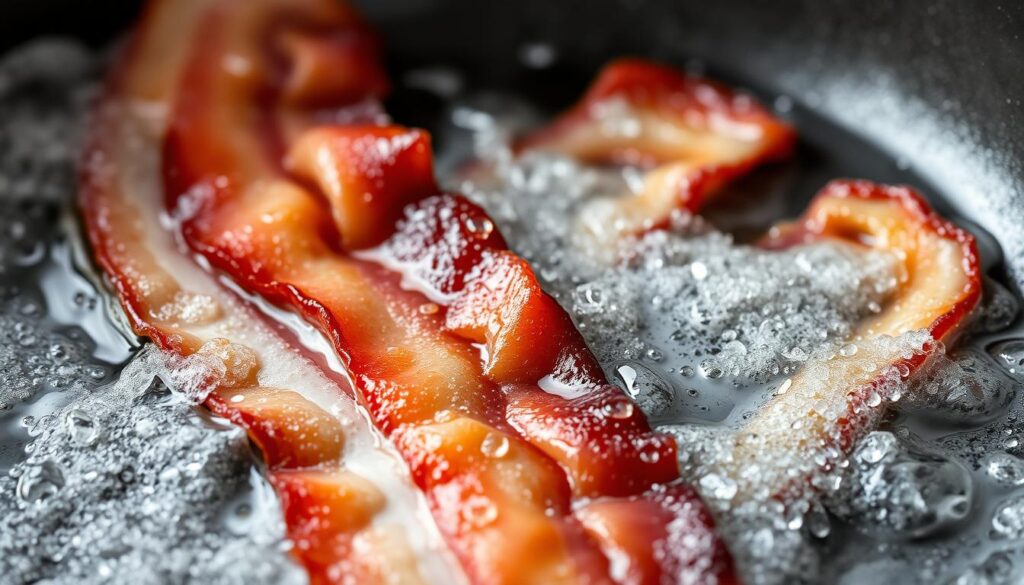
At first, I was unsure about adding water to bacon. Experts say water is key for cooking bacon right.
Understanding the Cooking Process
Cooking bacon with water is quite scientific. Here’s how it works:
- Start with a cold pan and bacon strips
- Add just enough water to cover the bottom of the pan
- Allow the water to boil and evaporate slowly
- Watch as the rendered bacon fat begins to crisp the meat
How Water Affects Temperature
Water is great at conducting heat. It helps keep bacon moist and cooks evenly. The water creates a controlled cooking space. This prevents bacon from burning and lets the fat render slowly.
| Cooking Method | Fat Rendering | Texture |
|---|---|---|
| Dry Frying | Uneven | Potentially Burnt |
| Water Method | Consistent | Crispy and Uniform |
Impact on Fat Rendering
The magic of this trick is how water works with bacon fat. As water boils, it spreads heat evenly. This lets bacon cook without direct flame. It makes the bacon fat release slowly, giving a crispy outside and moist inside.
“The key is patience and understanding the science behind cooking,” says Chef Marcus Rodriguez.
By using these tips, you can make your bacon cooking better.
Benefits of Adding Water to Your Bacon
Cooking bacon can be messy and unpredictable. My kitchen adventures have shown me that water is a secret weapon for perfect crispy bacon. This simple trick turns ordinary bacon cooking into a pro-level technique.
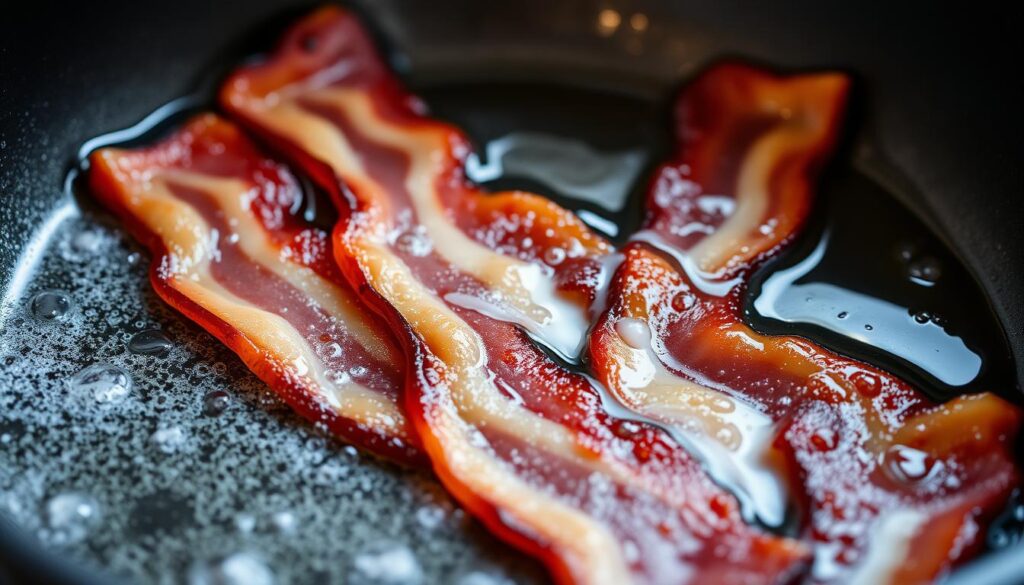
Let’s look at the amazing benefits of adding water to your bacon cooking:
Preventing Grease Splatter
Grease splatter is a big problem for home cooks. Adding a quarter cup of water to the pan can cut splattering by up to 50%. This trick keeps your stovetop clean and prevents oil burns.
- Reduces grease splatter dramatically
- Protects your skin from hot oil
- Keeps your cooking area cleaner
Ensuring Even Cooking
Water makes bacon cook evenly. It spreads heat evenly, avoiding burnt edges and undercooked centers. Chefs know that controlling temperature is key to perfect.
| Cooking Method | Cooking Time | Texture Result |
|---|---|---|
| Regular Dry Cooking | 8-10 minutes | Uneven, potentially burnt |
| Water Method | 10-15 minutes | Chewy-crisp, evenly cooked |
Enhancing Flavor and Texture
My experiments show water cooking reduces saltiness while keeping bacon flavor. It leaches out 5-10% of salt, making taste more balanced.
Water transforms bacon from good to extraordinary.
The result? Bacon that’s crispy outside, tender inside. It’s a culinary win that boosts your breakfast.
The Best Methods for Adding Water
Mastering bacon preparation is all about using professional cooking methods. Water is a secret ingredient that makes bacon crispy, tender, and flavorful.
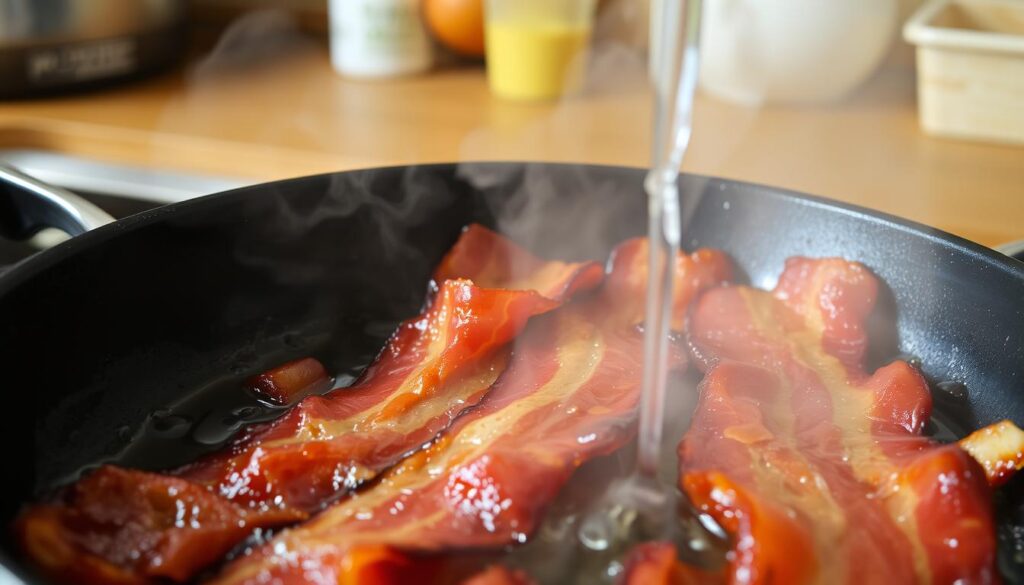
Professional chefs use special techniques to add water to bacon. They know exactly how much water to use and when. This turns simple cooking into an art.
Stovetop Techniques for Perfect Bacon
For stovetop bacon, I follow these culinary tips:
- Start with a cold pan and cold bacon strips
- Add just enough water to cover the bottom of the pan
- Cook on medium-low heat to ensure even rendering
Precision Oven Baking Methods
Oven baking is another great way to cook bacon. Here are some professional methods for amazing results:
| Oven Technique | Temperature | Cooking Time |
|---|---|---|
| Initial Cooking | 400°F | 15-20 minutes |
| Crisp Finish | 425°F | Last 5 minutes |
Pro tip: Use a wire rack to allow air circulation and prevent soggy bacon. This ensures each strip cooks to crispy perfection.
“The secret to great bacon is patience and precision in your cooking method.” – Culinary Professional
Using these water-based cooking techniques will make your bacon amazing. The right amount of water helps render fat evenly, reduces splatter, and makes bacon crispy on the outside and tender on the inside.
Common Misconceptions About Cooking Bacon
Bacon cooking techniques are often mixed with myths and truths. This can confuse home chefs. I’ve spent years learning about cooking bacon, and I’ve found many misconceptions.
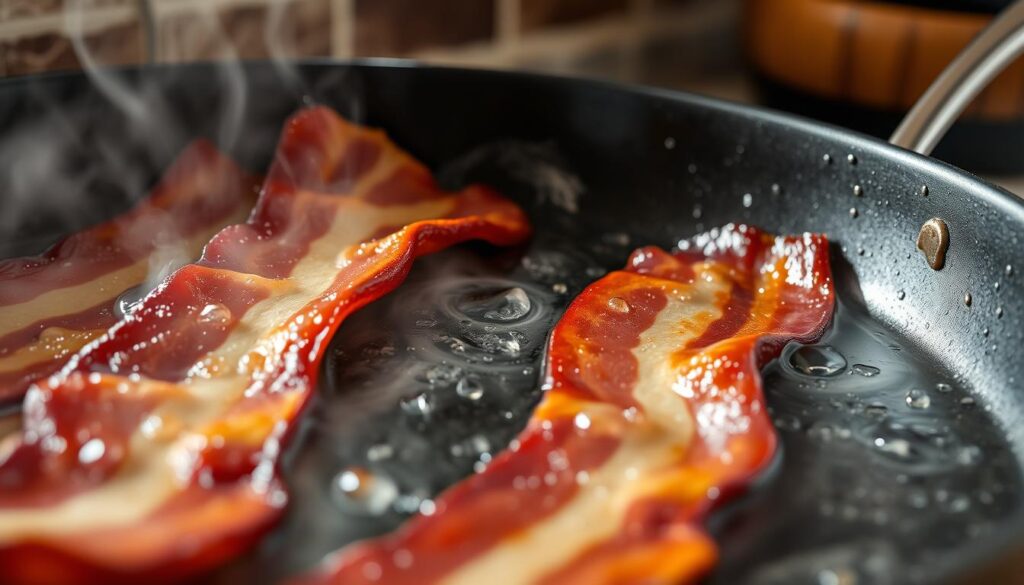
The world of bacon preparation is full of kitchen hacks that aren’t always right. Let’s look at some common misunderstandings about cooking bacon.
Debunking Water Myths in Bacon Preparation
Many home cooks think water is essential for cooking bacon. This isn’t always true. Different cooking mediums can also produce great results without water.
- Cold pan method can render fat effectively
- Oven baking works without water
- Microwave cooking can be successful
Understanding Cooking Medium Influences
The cooking medium greatly affects bacon’s texture and flavor. Chefs have tested many methods, sharing interesting insights.
| Cooking Method | Water Addition | Fat Rendering |
|---|---|---|
| Bare Pan | No | Medium |
| Water-Filled Pan | Yes | High |
| Oven | Optional | Excellent |
“Not all bacon cooking techniques are created equal. Experiment to find your perfect method!” – Culinary Expert
Nutritional considerations are also important. Bacon has 9 grams of protein and 60 grams of fat per 100 grams. It’s a rich ingredient that needs careful preparation.
Alternatives to Water for Cooking Bacon
There’s more to cooking bacon than just using water. Professional chefs use creative methods to make bacon taste better and feel different. These new ways can turn a simple breakfast item into a special dish.
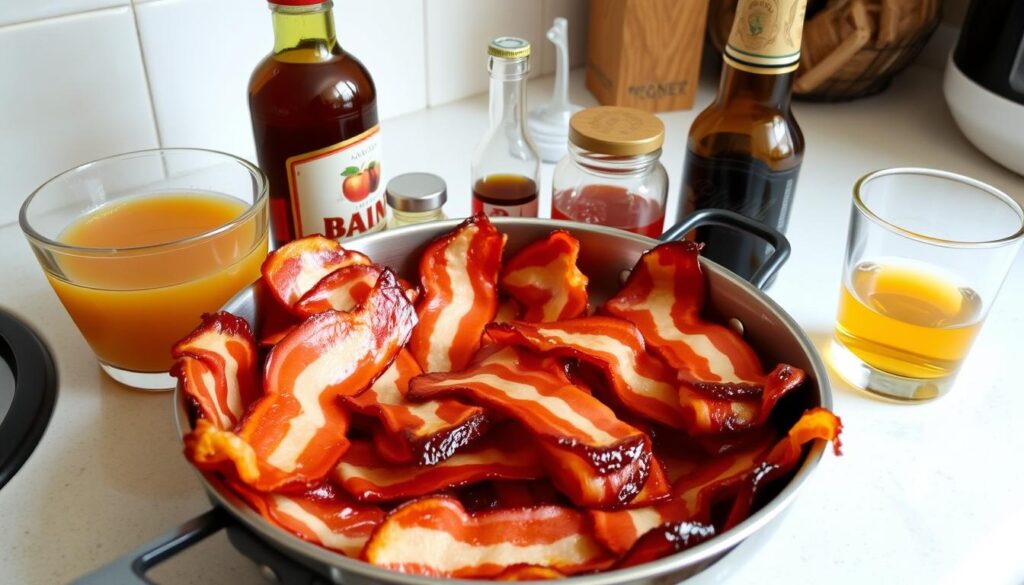
Chefs find unique liquids to make bacon taste deeper and more complex. Let’s look at some cool ways to cook bacon that can change your breakfast game.
Broths and Stocks: A Flavor Explosion
Using beef, chicken, or veggie stocks can make bacon taste amazing. These liquids offer:
- Deeper flavor than water
- More seasoning without adding extra stuff
- More umami taste
Adventurous Alcohol-Based Cooking Techniques
Cooks who love to try new things use alcohol to make bacon special. Wine and beer add unique flavors:
- Red wine brings earthy notes
- Beer adds a bit of bitterness and complexity
- Bourbon gives a sweet, smoky taste
“Cooking bacon is an art, and the right liquid can be your paintbrush.” – Chef Michael Richards
Start with small batches and try different things. Different bacons react differently to various liquids. So, feel free to experiment and find your favorite way to cook bacon.
My Personal Experience with Water and Bacon
Trying out different ways to cook bacon, I found a game-changer: using water. It turned my kitchen tricks into pro-level skills. I started noticing how water controls heat and cuts down on grease splatters.
Getting crispy bacon was a surprise. Covering bacon with water helped me avoid too much heat. It also let the fat melt evenly. This trick is great for cooking a whole pound of bacon, which takes about 14 minutes.
Favorite Recipes
I’ve made some amazing dishes using this water technique. My breakfast quiche is a hit because the bacon stays crisp without burning. I also love making bacon-wrapped asparagus. The water helps keep the bacon texture even.
Pro Tips for Perfect Bacon
For the best bacon, use a baking rack and let it cool for 5 minutes after cooking. Don’t overcrowd the pan. A little overlap is fine because bacon shrinks. With practice, you’ll get amazing results.
